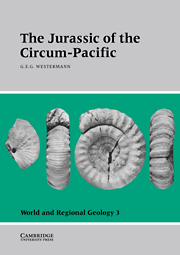Book contents
- Frontmatter
- Contents
- List of contributors
- Preface
- Acknowledgments
- Introduction
- Part I Time scales
- Part II Circum-Pacific base map
- Part III Regional geology and stratigraphy
- Part IV Biochronology
- Part V Biogeography
- Part VI Climatology and oceanography
- 27 Jurassic climate and oceanography of the Pacific region
- Appendix: Biochronology and atlas with index and guide fossils
- General Index
- Index of Guide- and Indexfossils
27 - Jurassic climate and oceanography of the Pacific region
Published online by Cambridge University Press: 04 August 2010
- Frontmatter
- Contents
- List of contributors
- Preface
- Acknowledgments
- Introduction
- Part I Time scales
- Part II Circum-Pacific base map
- Part III Regional geology and stratigraphy
- Part IV Biochronology
- Part V Biogeography
- Part VI Climatology and oceanography
- 27 Jurassic climate and oceanography of the Pacific region
- Appendix: Biochronology and atlas with index and guide fossils
- General Index
- Index of Guide- and Indexfossils
Summary
Introduction
Global paleobiogeographic patterns are principally dependent on climate and continental drift. This chapter presents conceptual models of geographically controlled climatic patterns and ocean-surface currents for two stages in the Jurassic period, in order to provide a climatic framework for the discussions of Jurassic biogeographic patterns presented elsewhere in this volume. Some of the climatic and biogeographic changes observed in the Jurassic circum-Pacific region are summarized here along with speculations on the causes of climatic change in the Jurassic.
The Jurassic was a time of climatic transition. The breakup of the supercontinent Pangea into Gondwana and Laurasia resulted in changes in continental climates in response to the breakdown of the northern Pangean monsoonal circulation (Parrish, Ziegler, and Scotese 1982; Parrish and Doyle 1984). This climatic change might have triggered changes in ocean circulation as well. Accordingly, the following discussion will emphasize monsoonal circulation.
Paleogeography and climate
On a planet with a homogeneous surface, climatic patterns would be controlled by the meridional thermal gradient and the rotation of the planet. The patterns would be zonal, and on Earth the zonal circulation consists of easterlies at the equator, westerlies in low midlatitudes, and easterlies in high midlatitudes. This circulation is well expressed today over the Pacific Ocean, which is wide enough to permit full expression of the zonal circulation. Land–sea contrast, which is the result of the lower thermal inertia of land compared with water, disrupts the zonal circulation by introducing an additional thermal component to the system.
- Type
- Chapter
- Information
- The Jurassic of the Circum-Pacific , pp. 365 - 380Publisher: Cambridge University PressPrint publication year: 1993
- 8
- Cited by

